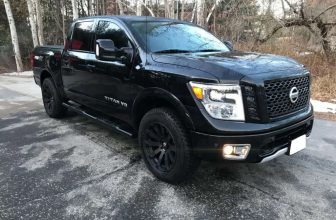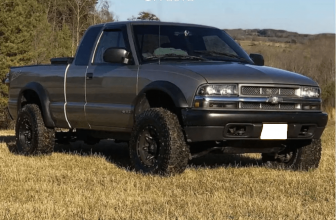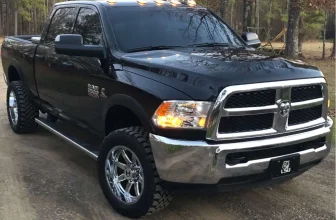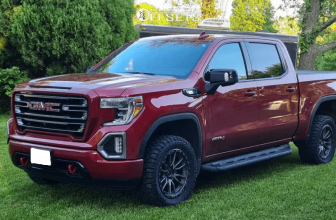If you are thinking about mounting bigger tires to your truck or SUV for either off-roading or just for the aesthetics purposes, you may probably need to make gear ratio changes.
Otherwise your vehicle will need more power and torque to rotate them. The rotation ability is directly tied with gear ratios.
All trucks and SUVs have different gear ratios depending on the manufacturer and vehicle purposes. Proper axle gear ratio with the engine, transmission, stock tire size work together to provide the vehicle with the optimum dynamics and fuel efficiency.
Changing gear ratios influences the amount of rotations of the driveshaft with each wheel rotation. On lower gears (bigger ratio) the engine rpm increases (taking into account the stock vehicle tire size and same speed).
A bigger tire size with the same engine rpm allows you to travel further with less wheel rotation. However, taking into account that larger tires are heavier than stock ones, soon you may face increased fuel consumption, decreased acceleration and lower level of comfort of your vehicle.
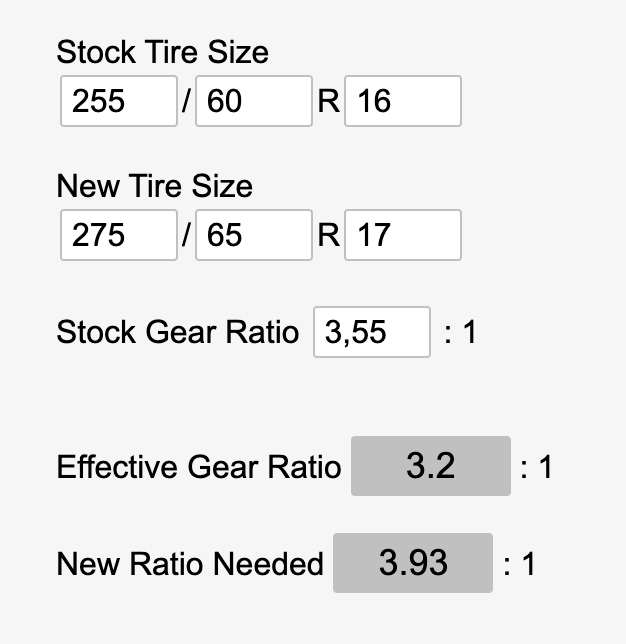
Owners of diesel trucks or SUVs are unlikely to encounter these issues. The thing is that diesel vehicles have a great amount of torque, so when you mount bigger tires you barely feel any power loss or worsen fuel efficiency.
If you want to use your truck everyday with bigger tires, gear ratio changes are necessary for the best driving experience. To do this you may need to replace the gears in the differential to increase the ratio of how many rotations of the driveshaft it takes to make one full rotation of the wheel.
Additionally, if you shift to lower gears, it will make up for some effects of larger tires, and if you choose the appropriate gear, it will make your rpm closer to the factory speed.
When you install bigger tires on your truck or SUV, almost in all cases you have to make extra upgrades among them speedometer and odometer alignments, choosing best shifting timelines on automatic transmission and actions concerning minimizing strain on the powertrain.
Calculating Appropriate Gear Ratio For Taller Tires
How to figure out the correct gear ratio for the bigger tires?
Let’s use some figures to see how it works in practice. For example, we need to know what gears should be applied for 34″ custom tires, when putting them on a transmission with 3.05 gear ratio instead of the stock 29” tires.
You can do it in different ways. One possible methodology relies on RPM as the proxy metric that will show the way out.
Naturally, to make use of the following algorithm you have to be familiar with the factory tire size (see it on the sidewall) and your current axle gear ratio. If you are not aware of your gear ratio, try running a search by VIN code that is located on driver’s door, the glove box, or the ID plate on the dashboard. Or try alternative ways to identify the gear ratio which require more effort.
In a nutshell, we need determine the engine’s RPM with the stock tire size and gear ratio at a given speed. Then we will be able to compare the stock RPM against the new tire size.
Check out the truck’s RPM at a certain speed with the stock setup. If you do not have the tachometer or sitting comfortably at home now, RPM value can be easily calculated with the formula below.
rpm = mph x gear ratio x 336 / tire diameter
We will need to discover at what rpm the engine is rotating at a particular speed, let it be 60 mph.
rpm = 60 x 3.05 x 336 / 29 = 2120Now we know that the engine’s RPM is 2120 (the stock truck setup). So we can insert the new tire size and calculate the gear ratio that delivers the RPM value that is close to the stock setup. If you do now want your speedo readings to differ from your actual speed.
To ease the process of searching for the best gear ratio for your truck or SUV, use the special formula below.
New Gear Ratio = (RPM * New Tire Diameter)/(mph*336)So if you want to mount 34 inch tires, now we can calculate the new gear ratio.
New Gear Ratio = (2120*34)/(60*336) = 3.57Double check that the RPM is really close to the original tire size.
60 x 3.57 x 336 / 34 = 2127As we can see from the result above, 3.57 gear ratio for 34” tires produces 2127 RPM which is very close to stock configuration.
It is worth mentioning that lower gears (bigger ratio) provides the vehicle with better acceleration on first gears and assists in better climbs, however the maximum speed decreases.
If higher gears (smaller ratio) has been applied, the maximum speed increases, but acceleration on lower gears suffers. In some cases you may need to do some research and dig deeper to find the best gear ratio for your truck or SUV.
Gear Ratio Chart
If you want to change your car’s tire size, it will affect its power and drivability. To retain the stock feel or change gearing to the optimal ratio, you need this gear ratio chart.
The input provides information on how to calculate the new gear ratio needed to achieve a specific RPM when switching to a different size tire.
This chart reflect the RPM of a drive gear at 1:1 while traveling 65 MPH. Note that automatic transmissions will have a higher RPM due to slippage.
The optimal RPM values are highlighted with the following the color codes to show:
Highway, Good Fuel Economy
Best Overall Performance
More Power, Reduced Fuel Economy
| Gear | Ratio | |||||||||||||||||
| Tire Diameter | 2.73 | 2.94 | 3.07 | 3.21 | 3.31 | 3.42 | 3.55 | 3.73 | 3.91 | 4.11 | 4.27 | 4.56 | 4.88 | 5.13 | 5.29 | 5.38 | 5.71 | 6.17 |
| 25″ | 2385 | 2568 | 2682 | 2804 | 2892 | 2988 | 3101 | 3259 | 3416 | 3590 | 3730 | 3984 | 4263 | 4482 | 4621 | 4700 | 4988 | 5390 |
| 26″ | 2293 | 2470 | 2579 | 2696 | 2780 | 2873 | 2982 | 3133 | 3284 | 3452 | 3587 | 3830 | 4099 | 4309 | 4444 | 4519 | 4796 | 5183 |
| 27″ | 2208 | 2378 | 2483 | 2597 | 2677 | 2766 | 2872 | 3017 | 3163 | 3325 | 3454 | 3689 | 3947 | 4150 | 4279 | 4352 | 4619 | 4991 |
| 28″ | 2129 | 2293 | 2395 | 2504 | 2582 | 2668 | 2769 | 2909 | 3050 | 3206 | 3331 | 3557 | 3806 | 4001 | 4126 | 4196 | 4454 | 4813 |
| 29″ | 2056 | 2214 | 2312 | 2417 | 2493 | 2576 | 2674 | 2809 | 2945 | 3095 | 3216 | 3434 | 3675 | 3863 | 3984 | 4052 | 4300 | 4647 |
| 30″ | 1987 | 2140 | 2235 | 2337 | 2410 | 2490 | 2584 | 2715 | 2846 | 2992 | 3109 | 3320 | 3553 | 3735 | 3851 | 3917 | 4157 | 4492 |
| 31″ | 1923 | 2071 | 2163 | 2261 | 2332 | 2409 | 2501 | 2628 | 2755 | 2896 | 3008 | 3213 | 3438 | 3614 | 3727 | 3790 | 4023 | 4347 |
| 32″ | 1863 | 2007 | 2095 | 2191 | 2259 | 2334 | 2423 | 2546 | 2669 | 2805 | 2914 | 3112 | 3331 | 3501 | 3610 | 3672 | 3897 | 4211 |
| 33″ | 1807 | 1946 | 2032 | 2124 | 2191 | 2263 | 2349 | 2469 | 2588 | 2720 | 2826 | 3018 | 3230 | 3395 | 3501 | 3561 | 3779 | 4083 |
| 34″ | 1754 | 1889 | 1972 | 2062 | 2126 | 2197 | 2280 | 2396 | 2512 | 2640 | 2743 | 2929 | 3135 | 3295 | 3398 | 3456 | 3668 | 3963 |
| 35″ | 1704 | 1835 | 1916 | 2003 | 2065 | 2134 | 2215 | 2328 | 2440 | 2565 | 2664 | 2845 | 3045 | 3201 | 3301 | 3357 | 3563 | 3850 |
| 36″ | 1656 | 1784 | 1862 | 1947 | 2008 | 2075 | 2154 | 2263 | 2372 | 2493 | 2590 | 2766 | 2961 | 3112 | 3209 | 3264 | 3464 | 3743 |
| 37″ | 1611 | 1735 | 1812 | 1895 | 1954 | 2019 | 2095 | 2202 | 2308 | 2426 | 2520 | 2692 | 2881 | 3028 | 3123 | 3176 | 3370 | 3642 |
| 38″ | 1569 | 1690 | 1764 | 1845 | 1902 | 1966 | 2040 | 2144 | 2247 | 2362 | 2454 | 2621 | 2805 | 2948 | 3040 | 3092 | 3282 | 3546 |
| 39″ | 1529 | 1646 | 1719 | 1798 | 1854 | 1915 | 1988 | 2089 | 2190 | 2302 | 2391 | 2554 | 2733 | 2873 | 2962 | 3013 | 3198 | 3455 |
| 40″ | 1491 | 1605 | 1676 | 1753 | 1807 | 1867 | 1938 | 2037 | 2135 | 2244 | 2331 | 2490 | 2664 | 2801 | 2888 | 2937 | 3118 | 3369 |
| 41″ | 1454 | 1566 | 1635 | 1710 | 1763 | 1822 | 1891 | 1987 | 2083 | 2189 | 2275 | 2492 | 2599 | 2733 | 2818 | 2866 | 3042 | 3287 |
| 42″ | 1420 | 1529 | 1596 | 1669 | 1721 | 1778 | 1846 | 1940 | 2033 | 2137 | 2220 | 2371 | 2538 | 2668 | 2751 | 2798 | 2969 | 3208 |
| 43″ | 1387 | 1493 | 1559 | 1630 | 1681 | 1737 | 1803 | 1894 | 1986 | 2087 | 2169 | 2316 | 2479 | 2606 | 2687 | 2733 | 2900 | 3134 |
| 44″ | 1355 | 1459 | 1524 | 1593 | 1643 | 1698 | 1762 | 1851 | 1941 | 2040 | 2119 | 2263 | 2422 | 2545 | 2626 | 2670 | 2834 | 3063 |



